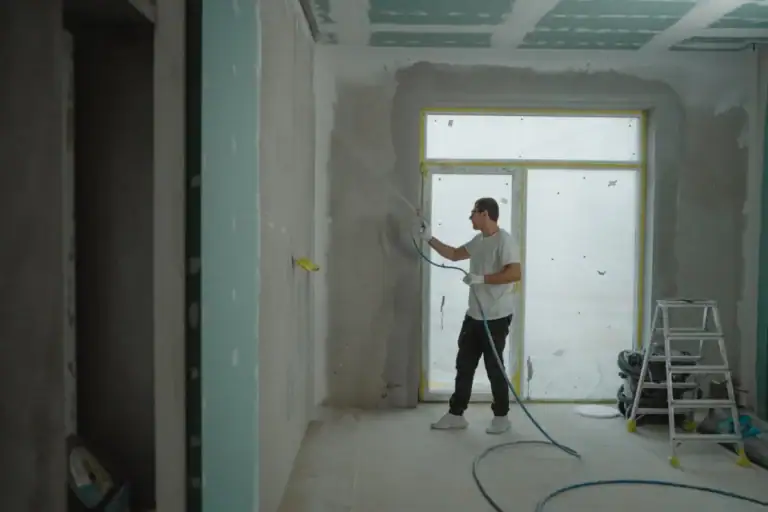
Hiring professional painters is one of the easiest ways to give your home a fresh, polished look. Whether you’re updating a single room or repainting the entire exterior, a little preparation on your part can save time, protect your belongings, and make the process run smoothly.
Think of it like this: your painting crew brings the expertise, tools, and quality paint, while you set the stage for them to work efficiently. To help you get ready, we’ve put together a professional painting preparation checklist. Follow these steps, and you’ll enjoy a stress-free painting experience with flawless results.
Step 1: Clear and Protect the Space
Before the painters arrive, remove as much furniture as possible from the room. Large items like sofas, cabinets, and beds can be moved to the center and covered with plastic sheets or drop cloths. Smaller items such as lamps, plants, and rugs should be taken out of the space entirely.
Why this matters:
A clear workspace allows the painters to move freely and work faster, while covering your furniture prevents accidental paint splatters or dust buildup.
Pro Tip:
If you’re painting multiple rooms, consider using your garage or renting a small storage pod for temporary storage.
Step 2: Take Down Wall Decor and Fixtures
Walls need to be fully accessible before painting begins. This means taking down framed artwork, mirrors, shelves, and curtains. Don’t forget fixtures like curtain rods or wall mounted hooks.
- Unscrew light switch plates and outlet covers if possible.
- Place hardware and screws into labeled bags for easy reinstallation.
Why this matters:
It ensures a smoother painting job with no obstacles, and your painter won’t have to work around fragile items.
Step 3: Address Minor Wall Repairs
Paint tends to highlight imperfections rather than hide them. Check your walls for small nail holes, dents, or cracks. These can be patched with spackles and sanded smoothly before painting.
If you’re not comfortable handling repairs, let your contractor know in advance. Many painting companies, including Two Brothers Painting can handle minor fixes as part of the prep.
Why this matters:
Repairing flaws in advance ensures the smoothest, most professional finish.
Step 4: Clean the Walls and Surfaces
Even if your walls look clean, dust, grease, and dirt can interfere with paint adhesion.
- Wipe down walls with a damp cloth.
- In kitchens or bathrooms, use a mild degreaser to remove residue.
- Vacuum baseboards and ceiling corners where cobwebs collect.
Why this matters:
Clean surfaces help paint bond evenly, preventing streaks, peeling, or bubbling.
Step 5: Create a Safe Environment
Painting involves ladders, tools, and open paint cans not an ideal setting for kids or pets.
- Secure pets in another room or arrange care outside the home.
- Keep children away from painting areas until the project is complete.
Why this matters:
A safe environment reduces stress and prevents accidents while allowing painters to work efficiently.
Step 6: Confirm Details with Your Painting Contractor
Good communication sets the tone for a smooth project. Before painting starts:
- Double check your chosen colors, finishes, and paint brands.
- Confirm the project timeline, including when rooms will be available again.
- Discuss any special requests, like accent walls or trim details.
Why this matters:
Confirming details avoids last minute changes, delays, or confusion.
Step 7: Plan for Ventilation and Access
Fresh paint needs proper airflow to dry. Ensure windows can open easily or that fans are available. If painters are working outside, unlock gates or side entrances so they can access the area without disruption.
Why this matters:
Ventilation speeds up drying time, and easy access helps painters work without interruptions.
FAQs: Common Questions Homeowners Ask Before Painting
Even with a checklist, many homeowners still have a few last minute questions. Here are some of the most common ones:
Do I need to remove wallpaper first?
Yes, it’s best to remove the wallpaper so the new paint adheres directly to the wall. If removal isn’t possible, painters may be able to prep and paint over it, but starting with a clean surface ensures the longest lasting results.
Should I prime the walls myself?
No, priming is usually part of a professional painter’s process. All you need to do is make sure the walls are clean, dry, and free from grease or dust.
When is it safe to move furniture back?
In most cases, you should wait 24–48 hours after painting before moving furniture back into place. This prevents smudges, fingerprints, or damage to the fresh finish.
What if I can’t repair all the wall damage beforehand?
That’s not a problem. Many painting companies, including Two Brothers Painting, can handle small wall repairs before painting begins. Just point out any issues during your pre-painting walkthrough.
Ready to Refresh Your Home?
Preparing your home for professional painting may take a little effort, but the results are worth it. By following this checklist, you’ll protect your home, save time, and ensure a smooth, stress free project.
Don’t wait to give your home a fresh new look, request your free estimate from Two Brothers Painting today and let Rhode Island’s trusted painting specialists transform your space.
Free Painting Estimate
Do not fill this form out if you’re a solicitor.

